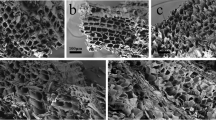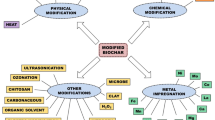Abstract
Biomasses have been used as adsorbents since they are inexpensive and can offer excellent performance in adsorption of pollutants and in water remediation. To increase their performance, thermal decomposition of biomass under oxygen-limited conditions to produce biochar has attracted increasing attention. The properties of biochar are affected by the preparation temperature and the type of biomass used. This work investigates the influence of the type of precursor tropical biomass used to prepare biochar with a high capacity for the adsorption of some polycyclic aromatic hydrocarbons (PAHs) in aqueous solution. Biochars prepared from coconut waste, elephant grass, orange waste, and guava waste were studied, and the adsorption behaviors were correlated to the chemical characteristics of the materials. The type of precursor tropical biomass determined the adsorption of PAHs by the biochars, being governed by π–π interactions, with those prepared using biomass with high lignin content showing better adsorption.




Similar content being viewed by others
References
Ahmad M et al (2014) Biochar as a sorbent for contaminant management in soil and water: a review. Chemosphere 99:19–23
Ahmed MB et al (2017) Single and competitive sorption properties and mechanism of functionalized biochar for removing sulfonamide antibiotics from water. Chem Eng J 311:348–358
Awoyemi A (2011) Understanding the adsorption of polycyclic aromatic hydrocarbons from aqueous phase onto activated carbon. Dissertation, University of Toronto
Bartle KD (1991) Analysis and occurrence of polycyclic aromatic hydrocarbons in food. In: Creaser CS, Purchase R (eds) P. 205 in food contaminants: source and surveillance. Woodhead Publishing Limited, Cambridge
Cha JS et al (2016) Production and utilization of biochar: a review. J Ind Eng Chem 40:1–15
Chen B, Yuan M, Liu H (2011) Removal of polycyclic aromatic hydrocarbons from aqueous solution using plant residue materials as a biosorbent. J Hazard Mater 188:436–442
Chen H et al (2014) Characterization of bio-oil and biochar from high temperature pyrolysis of sewage sludge. Environ Technol 36:470–478
Costa AS et al (2012) Environmental strategies to remove volatile aromatic fractions (BTEX) from petroleum industry wastewater using biomass. Bioresour Technol 105:31–39
Crisafully R et al (2008) Removal of some polycyclic aromatic hydrocarbons from petrochemical wastewater using low-cost adsorbents of natural origin. Bioresour Technol 99:4515–4519
de Jesus JHF, da Cunha GC, Cardoso EMC, Mangrich AS, Romão LPC (2017) Evaluation of waste biomasses and their biochars for removal of polycyclic aromatic hydrocarbons. J Environ Manag 200:186–195
FAO (2018) “FAO.” Retrieved June 28, 2018 (http://www.fao.org/faostat/en/#data)
Ferreira SD et al (2018) Use of biochar produced from elephant grass by pyrolysis in a screw reactor as a soil amendment. Waste Biomass Valorization. https://doi.org/10.1007/s12649-018-0347-1
García T, Murillo R, Cazorla-Amorós D, Mastral AM, Linares-Solano A (2004) Role of the activated carbon surface chemistry in the adsorption of phenanthrene. Carbon 42:1683–1689
Grasel FS et al (2017) Inovação Em Biorrefinarias I. Produção de Etanol de Segunda Geração a Partir de Capim-Elefante (Pennisetum Purpureum) e Bagaço de Cana-de-Açúcar (Saccharum Officinarum). Revista Virtual de Quimica 9(1):4–14
Lee D-J, Cheng Y-L, Wong R-J, Wang X-D (2018) Adsorption removal of natural organic matters in waters using biochar. Bioresour Technol 260:413–416
Lehmann J, Joseph S (2009) Biochar for environmental management: an introduction. In: Lehmann J, Joseph S (eds) Biochar for environmental management: science and technology. Earthscan Publications Ltd, Virginia
Mackay AA, Gschwend PM (2000) Sorption of monoaromatic hydrocarbons to wood. Environ Sci Technol 34:839–845
Marafon AC et al (2016) Uso da biomassa para a geração de energia. Doc/Embrapa Tabul Costeiros 211:1–29
Qian K, Kumar A, Zhang H, Bellmer D, Huhnke R (2015) Recent advances in utilization of biochar. Renew Sustain Energy Rev 42:1055–1064
Rosales E, Meijide J, Pazos M, Sanromán MA (2017) Challenges and recent advances in biochar as low-cost biosorbent: from batch assays to continuous-flow systems. Bioresour Technol 246:176–192
Sancho SDO et al (2015) Characterization of the industrial residues of seven fruits and prospection of their potential application as food supplements. J Chem 2015:1–8. https://doi.org/10.1155/2015/264284
Scholl AL et al (2015) Elephant grass (Pennisetum Purpureum Schum.) pretreated via steam explosion as a carbon source for cellulases and xylanases in submerged cultivation. Ind Crops Prod 70:280–291
Suliman W et al (2016) Influence of feedstock source and pyrolysis temperature on biochar bulk and surface properties. Biomass Bioenerg 84:37–48
Tag AT, Duman G, Ucar S, Yanik J (2016) Effects of feedstock type and pyrolysis temperature on potential applications of biochar. J Anal Appl Pyrol 120:200–206
Tan X et al (2015) Application of biochar for the removal of pollutants from aqueous solutions. Chemosphere 125:70–85
Tang J, Zhu W, Kookana R, Katayama A (2013) Characteristics of biochar and its application in remediation of contaminated soil. J Biosci Bioeng 116(6):653–659
Wang Y, Liu R (2017) Comparison of characteristics of twenty-one types of biochar and their ability to remove multi-heavy metals and methylene blue in solution. Fuel Process Technol 160:55–63
Weber K, Quicker P (2018) Properties of biochar. Fuel 217:240–261
Yang H, Yan R, Chen H, Lee DH, Zheng C (2007) Characteristics of hemicellulose, cellulose and lignin pyrolysis. Fuel 86:1781–1788
Yang K, Jiang Y, Yang J, Lin D (2018) Correlations and adsorption mechanisms of aromatic compounds on biochars produced from various biomass at 700 °C. Environ Pollut 233:64–70
Zhang P, Sun H, Ren C, Min L, Zhang H (2018) Sorption mechanisms of neonicotinoids on biochars and the impact of deashing treatments on biochar structure and neonicotinoids. Environ Pollut 234:812–820
Zheng H et al (2017) Bioresource technology adsorption of P-nitrophenols (PNP) on microalgal biochar: analysis of high adsorption capacity and mechanism. Bioresour Technol 244:1456–1464
Acknowledgments
This study was financed in part by Coordenação de Aperfeiçoamento de Pessoal de Nível Superior (CAPES, Finance Code 001). The authors also wish to thank the Brazilian funding agency CNPq (Grants #552518/2011-5 and #307029/2013-1).
Author information
Authors and Affiliations
Corresponding author
Additional information
Publisher's Note
Springer Nature remains neutral with regard to jurisdictional claims in published maps and institutional affiliations.
Electronic supplementary material
Below is the link to the electronic supplementary material.
Rights and permissions
About this article
Cite this article
de Jesus, J.H.F., da S. Matos, T.T., da C. Cunha, G. et al. Adsorption of aromatic compounds by biochar: influence of the type of tropical biomass precursor. Cellulose 26, 4291–4299 (2019). https://doi.org/10.1007/s10570-019-02394-0
Received:
Accepted:
Published:
Issue Date:
DOI: https://doi.org/10.1007/s10570-019-02394-0




